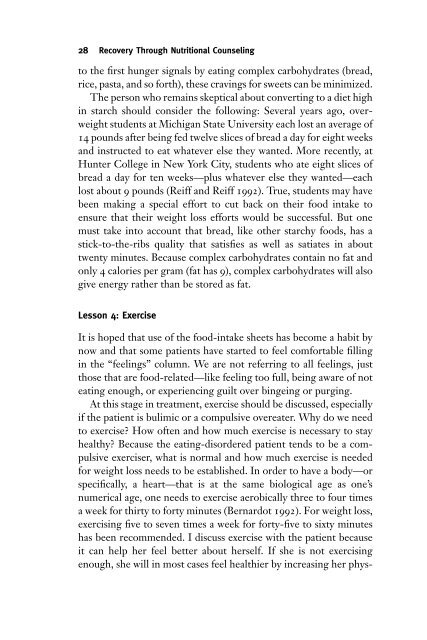Eating Disorders - fieldi
Eating Disorders - fieldi
Eating Disorders - fieldi
You also want an ePaper? Increase the reach of your titles
YUMPU automatically turns print PDFs into web optimized ePapers that Google loves.
28 Recovery Through Nutritional Counseling<br />
to the first hunger signals by eating complex carbohydrates (bread,<br />
rice, pasta, and so forth), these cravings for sweets can be minimized.<br />
The person who remains skeptical about converting to a diet high<br />
in starch should consider the following: Several years ago, overweight<br />
students at Michigan State University each lost an average of<br />
14 pounds after being fed twelve slices of bread a day for eight weeks<br />
and instructed to eat whatever else they wanted. More recently, at<br />
Hunter College in New York City, students who ate eight slices of<br />
bread a day for ten weeks—plus whatever else they wanted—each<br />
lost about 9 pounds (Reiff and Reiff 1992). True, students may have<br />
been making a special effort to cut back on their food intake to<br />
ensure that their weight loss efforts would be successful. But one<br />
must take into account that bread, like other starchy foods, has a<br />
stick-to-the-ribs quality that satisfies as well as satiates in about<br />
twenty minutes. Because complex carbohydrates contain no fat and<br />
only 4 calories per gram (fat has 9), complex carbohydrates will also<br />
give energy rather than be stored as fat.<br />
Lesson 4: Exercise<br />
It is hoped that use of the food-intake sheets has become a habit by<br />
now and that some patients have started to feel comfortable filling<br />
in the “feelings” column. We are not referring to all feelings, just<br />
those that are food-related—like feeling too full, being aware of not<br />
eating enough, or experiencing guilt over bingeing or purging.<br />
At this stage in treatment, exercise should be discussed, especially<br />
if the patient is bulimic or a compulsive overeater. Why do we need<br />
to exercise? How often and how much exercise is necessary to stay<br />
healthy? Because the eating-disordered patient tends to be a compulsive<br />
exerciser, what is normal and how much exercise is needed<br />
for weight loss needs to be established. In order to have a body—or<br />
specifically, a heart—that is at the same biological age as one’s<br />
numerical age, one needs to exercise aerobically three to four times<br />
a week for thirty to forty minutes (Bernardot 1992). For weight loss,<br />
exercising five to seven times a week for forty-five to sixty minutes<br />
has been recommended. I discuss exercise with the patient because<br />
it can help her feel better about herself. If she is not exercising<br />
enough, she will in most cases feel healthier by increasing her phys-









